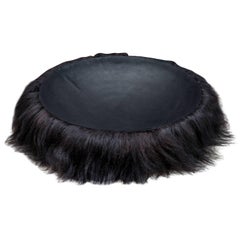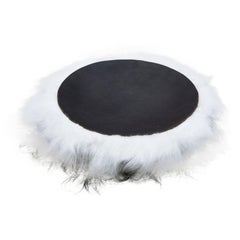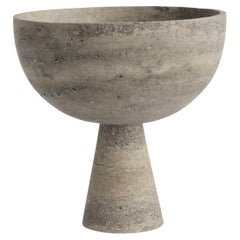Aluminum Decorative Bowls
4
to
1
4
4
4
4
Height
to
Width
to
2,185
229
169
134
130
4
4
4
Material: Aluminum
Recognized Seller Listings
Pankalangu Bowl
By Trent Jansen
Located in Beverly Hills, CA
Broached monsters by Trent Jansen
The vast majority of mainstream Australian mythology commonly used as a
foundation for Australian identity is culturally exclusive. Both Indigenous myths, including post-colonial myths and precolonial dreaming stories, and non-indigenous Australian myths, including the bush legend, ANZAC tradition and convict legend, focus on the historical role that the race of authorship has played in building the nation. However, a contemporary understanding of Australian history acknowledges the contribution of both Indigenous and non-indigenous Australians in forging the nation, and the national identity which accompanies it. Instead of perpetuating the same exclusive national myths, perhaps Australians should adopt a national mythology that acknowledges this inclusive understanding of Australian history, a mythology that unites Australians of many backgrounds under a shared Australian identity.
In his book on Australia’s Folklore of Fear, Robert Holden explores pre-colonial ideas of Australia as a Great Southern Land – an imaginary landmass conjured up to counterbalance the continents in the northern hemisphere, as far removed as possible from Britain, the center of the Christian world (Holden, 2001). Holden speaks of Australia as an imaginary world, occupied by unimaginable creatures and monsters.
Holden is commenting in part on the mythical creatures that originated in both British and Aboriginal Australian folklore and were shared by the Aboriginal and non-Aboriginal inhabitants of Sydney during the early years of colonisation. Stories of the yahoo, a creature that resembled a slender man, with long white straight hair, extraordinarily long arms and great talons (Unknown 1842), captured the imaginations of the new British settlers, and soon a fear of the yahoo became a common ground between Aboriginal people and British settlers. is fear of a gruesome and vicious creature gained its potency from the folkloric tales that were used to substantiate its existence. These tales were suitably vague, their lack of detail
attributed to the fierce nature of these creatures and the assumption that no one had survived an encounter (Holden, Thomas et al. 2001).
The yahoo “became one of the very few Aboriginal legends to be embraced by the Europeans” (Holden, Thomas et al. 2001, p16), providing a catalyst for conversation between individuals from these two culturally disparate societies and forming some personal links between these communities. Could creature myths like the yahoo once again form the foundation of a united national...
Category
21st Century and Contemporary Australian Aluminum Decorative Bowls
Materials
Aluminum
Hairy Wild Man from Botany Bay Bowl Grey by Trent Jansen
By Trent Jansen
Located in Beverly Hills, CA
Broached monsters by Trent Jansen
The vast majority of mainstream Australian mythology commonly used as a
foundation for Australian identity is culturally exclusive. Both Indigenous myths, including post-colonial myths and precolonial dreaming stories, and non-indigenous Australian myths, including the bush legend, ANZAC tradition and convict legend, focus on the historical role that the race of authorship has played in building the nation. However, a contemporary understanding of Australian history acknowledges the contribution of both Indigenous and non-indigenous Australians in forging the nation, and the national identity which accompanies it. Instead of perpetuating the same exclusive national myths, perhaps Australians should adopt a national mythology that acknowledges this inclusive understanding of Australian history, a mythology that unites Australians of many backgrounds under a shared Australian identity.
In his book on Australia’s Folklore of Fear, Robert Holden explores pre-colonial ideas of Australia as a Great Southern Land – an imaginary landmass conjured up to counterbalance the continents in the northern hemisphere, as far removed as possible from Britain, the center of the Christian world (Holden, 2001). Holden speaks of Australia as an imaginary world, occupied by unimaginable creatures and monsters.
Holden is commenting in part on the mythical creatures that originated in both British and Aboriginal Australian folklore and were shared by the Aboriginal and non-Aboriginal inhabitants of Sydney during the early years of colonisation. Stories of the yahoo, a creature that resembled a slender man, with long white straight hair, extraordinarily long arms and great talons (Unknown 1842), captured the imaginations of the new British settlers, and soon a fear of the yahoo became a common ground between Aboriginal people and British settlers. is fear of a gruesome and vicious creature gained its potency from the folkloric tales that were used to substantiate its existence. These tales were suitably vague, their lack of detail
attributed to the fierce nature of these creatures and the assumption that no one had survived an encounter (Holden, Thomas et al. 2001).
The yahoo “became one of the very few Aboriginal legends to be embraced by the Europeans” (Holden, Thomas et al. 2001, p16), providing a catalyst for conversation between individuals from these two culturally disparate societies and forming some personal links between these communities. Could creature myths like the yahoo once again form the foundation of a united national...
Category
21st Century and Contemporary Australian Aluminum Decorative Bowls
Materials
Aluminum
Hairy Wild Man from Botany Bay Bowl Black by Trent Jansen
By Trent Jansen
Located in Beverly Hills, CA
Broached Monsters by Trent Jansen
The vast majority of mainstream Australian mythology commonly used as a
foundation for Australian identity is culturally exclusive. Both Indigenous myths, including post-colonial myths and precolonial dreaming stories, and non-indigenous Australian myths, including the bush legend, ANZAC tradition and convict legend, focus on the historical role that the race of authorship has played in building the nation. However, a contemporary understanding of Australian history acknowledges the contribution of both Indigenous and non-indigenous Australians in forging the nation, and the national identity which accompanies it. Instead of perpetuating the same exclusive national myths, perhaps Australians should adopt a national mythology that acknowledges this inclusive understanding of Australian history, a mythology that unites Australians of many backgrounds under a shared Australian identity.
In his book on Australia’s Folklore of Fear, Robert Holden explores pre-colonial ideas of Australia as a Great Southern Land – an imaginary landmass conjured up to counterbalance the continents in the northern hemisphere, as far removed as possible from Britain, the center of the Christian world (Holden, 2001). Holden speaks of Australia as an imaginary world, occupied by unimaginable creatures and monsters.
Holden is commenting in part on the mythical creatures that originated in both British and Aboriginal Australian folklore and were shared by the Aboriginal and non-Aboriginal inhabitants of Sydney during the early years of colonization. Stories of the yahoo, a creature that resembled a slender man, with long white straight hair, extraordinarily long arms and great talons (Unknown 1842), captured the imaginations of the new British settlers, and soon a fear of the yahoo became a common ground between Aboriginal people and British settlers. is fear of a gruesome and vicious creature gained its potency from the folkloric tales that were used to substantiate its existence. These tales were suitably vague, their lack of detail
attributed to the fierce nature of these creatures and the assumption that no one had survived an encounter (Holden, Thomas et al. 2001).
The yahoo “became one of the very few Aboriginal legends to be embraced by the Europeans” (Holden, Thomas et al. 2001, p16), providing a catalyst for conversation between individuals from these two culturally disparate societies and forming some personal links between these communities. Could creature myths like the yahoo once again form the foundation of a united national...
Category
21st Century and Contemporary Australian Aluminum Decorative Bowls
Materials
Aluminum
Hairy Wild Man from Botany Bay Bowl White by Trent Jansen
By Trent Jansen
Located in Beverly Hills, CA
Broached Monsters by Trent Jansen
The vast majority of mainstream Australian mythology commonly used as a
foundation for Australian identity is culturally exclusive. Both Indigenou...
Category
21st Century and Contemporary Australian Aluminum Decorative Bowls
Materials
Aluminum
Related Items
Travertine Eclipse Bowl
Located in EINDHOVEN, NB
Stunning, aesthetic, timeless are words that can be used to describe this elegant and modern travertine Eclipse bowl from Kiwano. Expertly crafted and finished by hand, our travertin...
Category
2010s Dutch Modern Aluminum Decorative Bowls
Materials
Travertine
Silver Travertine Bowl XL
Located in EINDHOVEN, NB
A substantial silver travertine bowl with unique structure rests atop a pedestal for a grand presentation of fruits and vegetables.
Due to the nature of the material, each piece ...
Category
2010s Dutch Modern Aluminum Decorative Bowls
Materials
Travertine
Travertine Narrow Bowl
Located in EINDHOVEN, NB
Stunning, aesthetic, timeless are words that can be used to describe this elegant and modern travertine bowl from Kiwano. Expertly crafted and finished by hand, our travertine bowls ...
Category
2010s Dutch Modern Aluminum Decorative Bowls
Materials
Travertine
Silver Travertine Narrow Bowl
Located in EINDHOVEN, NB
Stunning, aesthetic, timeless are words that can be used to describe this elegant and modern travertine bowl from Kiwano. Expertly crafted and finished by hand, our travertine bowls ...
Category
2010s Dutch Modern Aluminum Decorative Bowls
Materials
Travertine
Pink Marble Narrow Bowl
Located in EINDHOVEN, NB
Stunning, aesthetic, timeless are words that can be used to describe this elegant and modern pink marble narrow bowl from Kiwano. Expertly crafted and finished by hand, our traverti...
Category
2010s Dutch Modern Aluminum Decorative Bowls
Materials
Travertine
Vintage Art Glass Bowl by Chribska Glasswork, 1960s
Located in Praha, CZ
Beautiful vintage art glass bowl made by the famous Chribska Glasswork in former Chechoslovakia in the 1960s. There is an engraved mark '1414' a...
Category
1960s Czech Mid-Century Modern Vintage Aluminum Decorative Bowls
Materials
Art Glass
Travertine Bowl With Lid
Located in EINDHOVEN, NB
Stunning, aesthetic, timeless are words that can be used to describe this elegant and modern travertine bowl from Kiwano. Expertly crafted and finished by hand, our travertine vases ...
Category
2010s Dutch Modern Aluminum Decorative Bowls
Materials
Marble
Parana Ceramic Fruit Bowl, by Masanori Umeda from Memphis Milano
Located in La Morra, Cuneo
Trigonal ceramic fruit bowl in pastel colors was originally designed by Masanori Umeda in 1983 for Memphis Milano.
Was born in 1941 at Kanagawa in Japan. He obtained his diploma fro...
Category
21st Century and Contemporary Italian Modern Aluminum Decorative Bowls
Materials
Ceramic
Large Danish Teak Bowl by Richard Nissen
By Nissen, Richard Nissen
Located in Fort Lauderdale, FL
Large vintage danish teak bowl by Nissen.
Designer: Richard Nissen
Manufacturer: Nissen Studios
Year: 1960s
Origin: Denmark
Dimensions: 5" tall x 11" diameter.
Category
Mid-20th Century Danish Mid-Century Modern Aluminum Decorative Bowls
Materials
Teak
Broccoli Fruit Bowl, by Marco Zanini from Memphis Milano
Located in La Morra, Cuneo
Ceramic three-level fruit bowl originally designed by Marco Zanini in 1985 for Memphis Milano. The three geometrical shapes in three colors complete the idea of a trilogy.
Marco Zan...
Category
21st Century and Contemporary Italian Modern Aluminum Decorative Bowls
Materials
Ceramic
La Bocca Bowl by Marcela Cure
Located in Geneve, CH
La Bocca bowl by Marcela Cure.
Dimensions: W 32 x D 22 x H 26 cm.
Materials: resin and stone composite.
Our La Bocca bowl is inspired by the fascinating and provocative figure o...
Category
2010s Colombian Post-Modern Aluminum Decorative Bowls
Materials
Stone
Vintage Mexican Terracotta Bowl
Located in Chicago, IL
A beautiful vintage Mexican terracotta bowl with two handles, a ruffled lip, two large drip glazed splotches inside. The exterior is unglazed. Perfect f...
Category
20th Century Mexican Rustic Aluminum Decorative Bowls
Materials
Terracotta
Previously Available Items
Ode to the Wrong Angle No. 12, USA
Located in New York, NY
Ode to the Wrong Angle is a series comprised of sculptural vessels created through the artist’s experiments in his studio employing unique materials and textures. Gander begins with ...
Category
2010s American Aluminum Decorative Bowls
Materials
Aluminum
Recently Viewed
View AllMore Ways To Browse
Antique Decorative Bowls 8
Trinket Bowl
Root Bowl
Bowl Postmodern
Vintage Apple Baskets
Antique White Mortar
Vintage Copper Enamel Bowl
Scandinavian Wood Bowl
Green Stone Bowl
Alfredo Barbini Dish
Porcelain Fish Bowls
Small Asian Basket
Murano Ashtray Gold Fleck
Footed Brass Bowl
Vintage Asian Bowl
Del Campo Italy
Green And White Blown Glass Bowl
Small Basket With Lid






